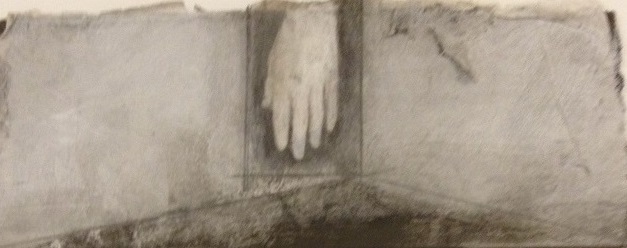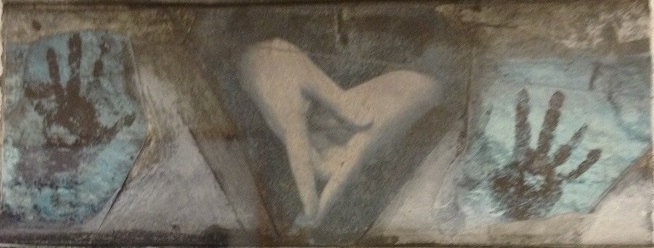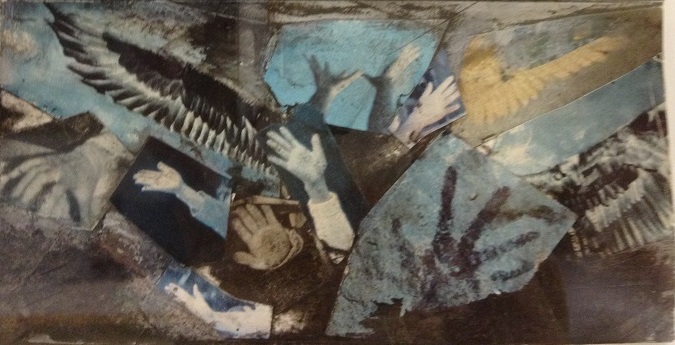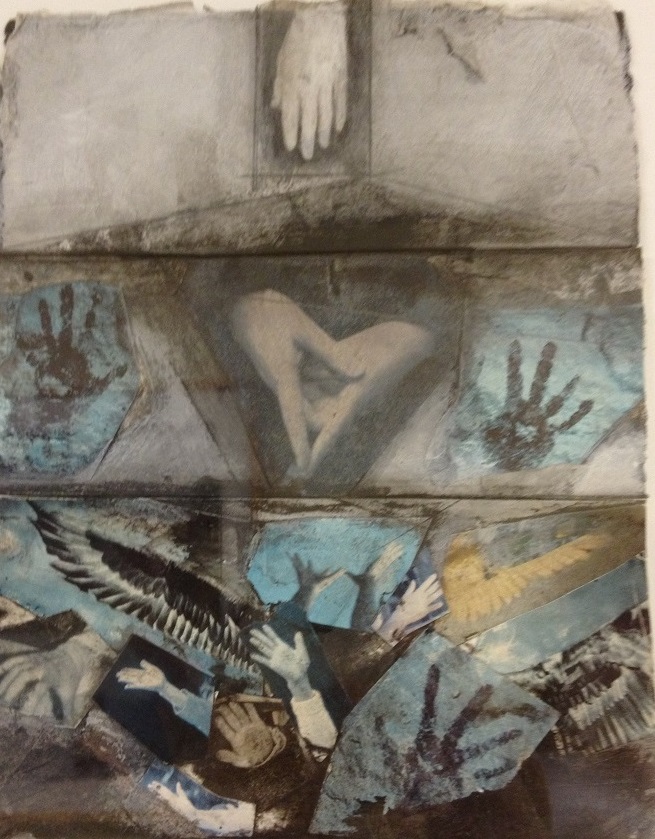Positive Health Online
Your Country

The Poetics of Touch
by David Lauterstein(more info)
listed in bodywork, originally published in issue 254 - May 2019
Greek poesis – “making”
Latin toccare – “to strike, ring a bell, touch”
A philosopher/poet much admired by Ida Rolf, the great innovator in modern bodymind therapy, was Gaston Bachelard. One day I was reading his “Poetics of Reverie” and was struck, like Ms. Rolf, by the parallels with bodymind work. Bachelard was looking at the reveries evoked by written poetry. Reverie gives us beautiful imagery for the experience of a person dwelling for a time in that state which is neither conscious nor unconscious; it is the meeting place of the two.
Intrigued with this consideration of reverie, I “translated” Bachelard’s ideas into a different series of evocative paragraphs. Here it is intentional touch, rather than words, that is the focus for the exploration of reverie.
Modern bodymind therapies are as much art as science. Yet the art is more elusive to talk about. The science is eminently teachable and testable. Notoriously in the US national examinations do not have a practical component, therefore licensing indicates largely that the candidate has answered questions primarily on anatomy and physiology. The quality of their touch is completely ignored.
May the Poetics of Touch help guide us to re-value the remarkable realms of mind and body creativity and the fact that a well-placed touch, what I call a fulcrum, often gives rise to an experience as enriching and transformative as the reveries evoked by beautiful words. In the beginning, is the touch. The words come later.
Note on the Text
- 1. *“Fulcrum” in Zero Balancing and Deep Massage: Lauterstein Method means a quality of a touch which simultaneously, consciously, and clearly contacts the client’s energy as well as physical structure. It helps give rise to an experience in which the person comes into a new balance, a new experience of health in bodymind. Moshe Feldenkrais said, “a person can not change unless they have a new experience.” In massage and bodywork, seeing what we are doing as placing fulcrums within the person’s being through touch, helps evoke new transformative experience.
- The word "haptic" refers to the bodily felt experience of reality - that includes touch, but also can be used as in climbing a mountain is a way to haptically experience it (includes the experience of proprioception, etc.).

Top Segment of Collage by Julie Lauterstein
I
The importance of this phenomenological inquiry lies in the complete illumination of the awareness of a subject who is struck with wonder by the experience arising from a fulcrum.* By obliging us to retrace our steps systematically and make an effort toward clarity of awareness with respect to a particular fulcrum, the phenomenological method leads us to attempt communication with the co-creative experience of the therapist and client (or, we might say, the creative power of haptic reality).
The experience newly born through a fulcrum – perhaps a ‘simple’ touch – thus becomes quite simply an absolute origin, an origin of consciousness. In times of great discoveries, a fulcrum can be the seed of a world (like a seed syllable or a poetic image), the seed of a universe imagined out of the therapist’s and/or client’s inspiration (like the poet’s reverie).
The consciousness of wonder blossoms forth in all innocence before this world co-created by therapist and client.
II
In a fulcrum, wonder is coupled with the joy of touch. This joy must be considered in its absolute positiveness appearing as a new being in the person’s experienced world. The fulcrum is one of the destinies of touch. In trying to sharpen the awareness of touch at the level of fulcrums, we get the impression that we are contacting a touch that is new in that it is not limited to expressing ideas or sensations or intentions, but tries to have a future.
One would say that the fulcrum, in its newness, opens a future to experience.
III
Faced with new haptic experiences which therapists evoke in us, experiences which we perhaps never could have imagined ourselves, the naïveté of wonderment is completely natural. But in submitting passively to such touch, one does not participate profoundly enough in the creating imagination. The phenomenology of inspired touch requires that we participate actively in the realm of creative imagination. Ah! If only the experience, which has just been given to me, could be mine, really mine. What a glorious experience therapy would be if I could be the source, with the therapist’s help, of the inspired creation of new transformational experience.

Mid Segment of Collage by Julie Lauterstein
IV
Reverie is commonly classified among the phenomena of psychic détente. It is lived out in a relaxed time which has no linking force. Since it functions with inattention, it is often without memory. It is a flight from out of the real that does not always find a consistent unreal world. By following “the path of reverie” – a constantly downhill path – consciousness relaxes and wanders and consequently becomes clouded. So it is never the right time, when one is dreaming, to “do phenomenology.”
However, rather than this being a conflict we need to reconcile, we can just note that any awareness is an increment to consciousness, an added light, a reinforcement of psychic coherence. Its swiftness or instantaneity can hide this growth from us. But there is a growth of being in every instance of awareness. Even if the action which would ordinarily follow remains in suspense, the consciousness-as-act is still completely positive or kinetic. In the present essay we shall study this act primarily in the realm of touch, and more precisely yet in conscious touch when the imagining consciousness creates and lives out the act of touching.
V
The reverie we intend to study is, strictly speaking, autopoetic reverie (from poesis “to make” and auto “self”). “Poetic” reverie, per se, uses words which arise from and return us to an inspirational state of being. When we use the term “reverie” here, let us rather take it to include poetic reverie but more generally the reverie evoked by fulcrums, non-verbal or verbal, often giving rise to new experiences and new developments in one’s life. Autopoetic reverie is a state of being from which new life springs.
This is a reverie which our living puts on the right track; the track an expanding consciousness follows. This reverie is embodied in life or at least promises to be embodied. It is already facing the great universe of our destiny. Then experiences begin to arise and fall into place. The autopoetic dreamer is already feeling the assembling elements of one’s evolution.
All the senses, mind and body awaken and fall into harmony in this reverie.
Reverie listens to this polyphony and the autopoetic nature lives it out.
VI
To be evoked, this reverie must come from a touch with thoughtfulness and emotion, loyal to the mysterious wisdom of another’s self-making. Here, we are touching the realm of living love. Here are souls for whom love is the contact of two poetries, the interface of autopoeses. And love is never finished expressing itself, and expresses itself better the more poetically it is dreamed. The interface of two solitary souls prepares the sweetness of loving.
VII
Creative touch tends to restore the innovating action of the self-making imagination. We can understand the great value in establishing this phenomenology of the creative imagination - where the imaginative experience of one’s body, mind and spirit is restored to its proper, all-important place as the principle of direct stimulation of psychophysical becoming. This is the imagination which attempts to have a future. At first it is an element of imprudence which detaches us from heavy stabilities. We shall see that certain reveries are hypothetical lives which enlarge our lives by letting in on the secrets of the universe. A world takes form in our reverie, and this world is ours.
The dreamed world teaches us the possibilities for expanding our being within our universe.
VIII
The waking dreamer comes upon the splendors of the day in the twi-light. Then he is conscious of the beauty of the world. The beauty of the dream world returns his consciousness to him for an instant.
And thus it is that reverie illustrates repose for a being, that it illustrates well-being. The dreamer and his reverie enter totally into the substance of happiness.
During a visit to Nemours in 1844, Victor Hugo had gone out at twilight “to go see a few bizarre paving stones.” Night was coming, the city was quieting down. Where was the city?
“All that was neither a city, nor a church, nor a river, nor color, nor light, nor shadow: it was reverie.
For a long time, I remained motionless, letting myself be penetrated gently by this unspeakable ensemble, by the serenity of the sky and the melancholy of the moment.
I do not know what was going on in my mind, and I could not express it; it was one of those ineffable moments when one feels something in himself which is going to sleep and something which is awakening.”
IX
Thus a whole universe comes to contribute to our happiness when reverie comes to accentuate our repose. You must tell the person who wants to dream well to begin by being happy. Then reverie plays out its veritable destiny; it becomes autopoetic reverie and by it, in it, everything becomes beautiful. Each dreamer has this gift, and can turn his reverie into a lifework. And this work has grandeur since the dreamed world is automatically so majestic.

Bottom Segment Collage by Julie Lauterstein
X
Autopoetic reverie is a cosmic reverie, an opening to beautiful worlds. It gives the I a non-I. It is this “non-I’ which enchants the I of the dreamer and which great bodymind work can help us share. This non-I lets me fulfill my secret of being in the world.
The demands of our reality function require that we adapt to reality. But doesn’t reverie, by its very essence, liberate us from the reality function? From the moment it is considered in all its simplicity, it is perfectly evident that reverie bears witness to a normal, useful irreality function.
Through imagining, thanks to the subtleties of the irreality function, we re-enter the world of confident being, which is the proper world for reverie.
Cosmic reveries separate from “project” reveries. They situate us in a world and not in a society. The cosmic reverie possesses a sort of stability and tranquility. It helps us escape time. It is a state of the soul.
Patience in instructing itself throughout history is natural to the soul. It does not live on time’s edge. The soul finds its rest in the universe imagined by reverie.
XI
Reverie puts us in the state of a soul being born. In this modest study of the simplest touches, our ambition is great. It is to prove that an effective fulcrum bears witness to a soul which is discovering its world, the world where it would like to live and where it deserves to live.
XII
Deep experiences form the dreamer and her world at the same time. Good reverie really helps the soul take advantage of its rest and of an easy unity. Reverie weaves soft bounds around the dreamer; it is a “binding” through which the dreamer constitutes him or herself. All the psychic forces increasingly fall into harmony.
I am a dreamer of worlds. I think I am living my life; an experience stops me. I leave the moment. The parts of my life begin to move around. Existential stresses begin to invert.
What I habitually think of as my self abandons its usual definition like an overload which is too heavy and prevents dreaming. Experiences take on new meanings and new forms as if all had the right to be young.
XIII
Yet it is more difficult when, instead of dreaming myself, I begin to touch the dreaming person (the person in the working state of self-making, of “autopoesis”). Under the hand, the anatomy of the dreaming world slowly unfolds.
Touch lives in moments of movement and stillness, in danger of being lost in internal reveries. The problem remains how to maintain the strength and clarity of touch, while new worlds unfold all around and within us. Doesn’t reverie ramify the touch that has begun? Each touch is a bud attempting to become a twig. How can one not dream while touching? The free human gives us the right to dream.
XIV
Touch in the distant past, holds the mysterious past of reveries. For the dreams of touch, they are all swollen with alive and wild meanings. Let anyone dream, and incubate a very familiar touch for a little while. Then the most unexpected rare things may hatch out of touch that were sleeping deeper within, like a fossil of meaning.
Yes, touch really does dream.

Full Collage by Julie Lauterstein
XV
To develop a psychology of the creating self, we want to distinguish clearly between imagination and memory. If there is any realm where this distinction is especially difficult, it is the realm of powerful images harbored in memory since childhood. These memories become at certain moments in our lives and particularly during quiet times, the origin and matter of a complex transformation: memory dreams, reverie remembers, and inspires action.
Where this reverie of remembering becomes the germ of new life, the complex of memory and imagination becomes more tightly meshed; and makes for multiple and reciprocal actions which transcend the person’s conscious will and self. More exactly, the childhood memories are potentiated, then redeemed in the person’s life-making actions, which ceaselessly revive, renew and illustrate our dreams.
XVI
Childhood lasts all through life.
It animates broad sections of adult life. First, it never leaves its nocturnal retreats. Within us, often a child comes to watch over us in our sleep. But in waking life itself, when reverie works on our history like a divine therapist, the childhood, which is within us, brings us its living benefits.
One needs to live with the child which he has been. From such living we achieve a consciousness of roots, and the entire tree of being takes nourishment from it. Bodymind work helps us find this living childhood within us, this permanent, durable, ever-present world.
This work then constitutes a living elegy. Through a touch which re-members, our reveries are empowered to liberate the action potentials of our history. For the past has the magical power to be simultaneously completely gone and yet, through its enduring influence, present within every moment.
The exploration of reveries and childhood is a deep contribution to the metaphysics of elegiac time. This exploration helps us establish a working draft for a metaphysics of the unforgettable.
Comments:
-
No Article Comments available